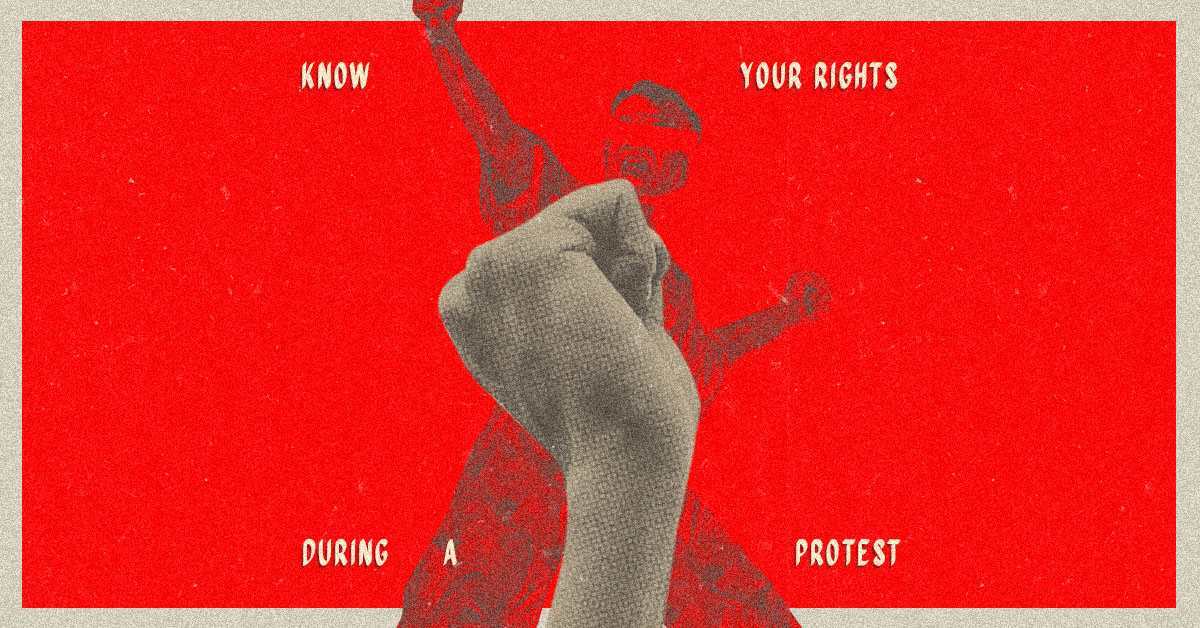Things to know before you exercise your right to freedom of expression and assembly
In a June media briefing, World Health Organization director-general Tedros Adhanom Ghebreyesus expressed that even in the middle of the pandemic, public protests remain important. “We encourage all those protesting around the world to do so safely,” he said. “As much as possible, keep at least one meter from others, clean your hands, cover your cough and wear a mask if you attend a protest.”
Filipinos heed this call when they, too, gather to rally for or against various issues. But attempts to mobilize today have become challenging and to some degree, dangerous. Still, people have the right to express their grievances and it is therefore imperative that protesters know their rights.
For guidance on the subject matter, we turn to Attorney Ronifelle Barrios, an Associate Lawyer at Javier Santiago Torres & Panghulan Law Offices. Ahead, she sheds light on protester rights and things to keep in mind when encountering law enforcement during a protest.
RELATED: On Pride, Independence & Taking A Social Stance
Wonder: Can we set the record straight about protesting? What does the law say about what is and isn’t allowed?
Atty. Barrios: Public assemblies, which include protest mobilization, rallies, demonstrations and other forms of mass concerted actions, are all regulated by Batas Pambansa 880 or the Public Assembly Act of 1985. (Note, however, that picketing and strikes resulting from labor disputes are not regulated by the Public Assembly Act.)
In order to organize and hold a public assembly in a public space, a written permit is required of any group. This is something that can be requested from the local government (LGU) of the place of assembly. No permit, however, should be required if the public assembly is made in a freedom park duly established by law or ordinance, within a private property or on the campus of a government-owned and operated educational institution, which should be subject to the rules and regulations of the said educational institution.
W: With the remaining quarantine period in mind, what should protesters consider?
Atty. Barrios: Today, stricter measures are being taken into consideration due to the pandemic, so mass demonstrations must abide by the rules of the community quarantine like social distancing and mask-wearing. This is advised by the Inter-Agency Task Force on Emerging Infectious Diseases, Department of Health and the LGU concerned.
W: Do protesters have the right to demand the names of law enforcers apprehending them?
Atty. Barrios: Yes, protesters have the right to know the name and authority of the apprehending officer. In fact, it is the duty of the apprehending officer, especially when it comes to cases of warrantless arrests, to inform the person of his authority and cause of the arrest.
It is also advisable to ask the officer his or her name in a calm and polite manner.
“Failure to observe the Miranda Doctrine is a violation of the constitutional rights of the accused.
Accordingly, the arrest should be void.”
W: For those thinking of participating in a protest, what are the other rights they should be aware of?
Atty. Barrios: It is our fundamental right to exercise freedom of expression, peaceful assembly and association. For safety reasons, they have the right to take pictures or videos especially if they are in a public place.
Aside from their rights, protesters must familiarize themselves with prohibited acts by government enforcers. These include the unjustified and arbitrary refusal to accept or acknowledge receipt of the application for a permit by the mayor or by any official acting on his behalf. These also touch on obstructing, impeding, disrupting or otherwise denying the exercise of the right to peaceful assembly. Lastly, there’s the unnecessary firing of firearms by a member of any law enforcement agency or any person to disperse the public assembly.
W: Lastly (and maybe most importantly), when is the apprehension of protesters actually allowed?
Atty. Barrios: As a general rule, no public assembly—with or without a permit—should be dispersed.
However, when an assembly becomes violent, the police may disperse such public assembly: First, at the first sign of impending violence; second, if actual violence [gets] to a point where rocks or other harmful objects from the participants are thrown at the police or at non-participants or at any property causing damage to such property; and third, the participants in a public assembly violates a law, statute, ordinance or any provision of this Act.
Overall, I believe that freedom to express oneself, to voice opinions without restraint is one of the most important blessings of democracy and expression of humanity. And in the case of public assemblies, the government can only intrude this right if it will create a clear and present danger to public order, public safety, public convenience, public morals or public health.
When it does come to arrests, the apprehending officers should observe the Miranda Doctrine: to inform the person arrested of his right to remain silent, of the nature of the accusations against him and his right to call a lawyer. Failure to observe the Miranda Doctrine is a violation of the constitutional rights of the accused. Accordingly, the arrest should be void.
RELATED: The Best Films and Documentaries to Watch on Social Justice
Staying informed is key. Knowing your rights as a citizen is essential. To secure a copy of your civil and political rights at a glance, hit save on the Paralegal Bust Card by Karapatan.org found here.
Art Alexandra Lara


















